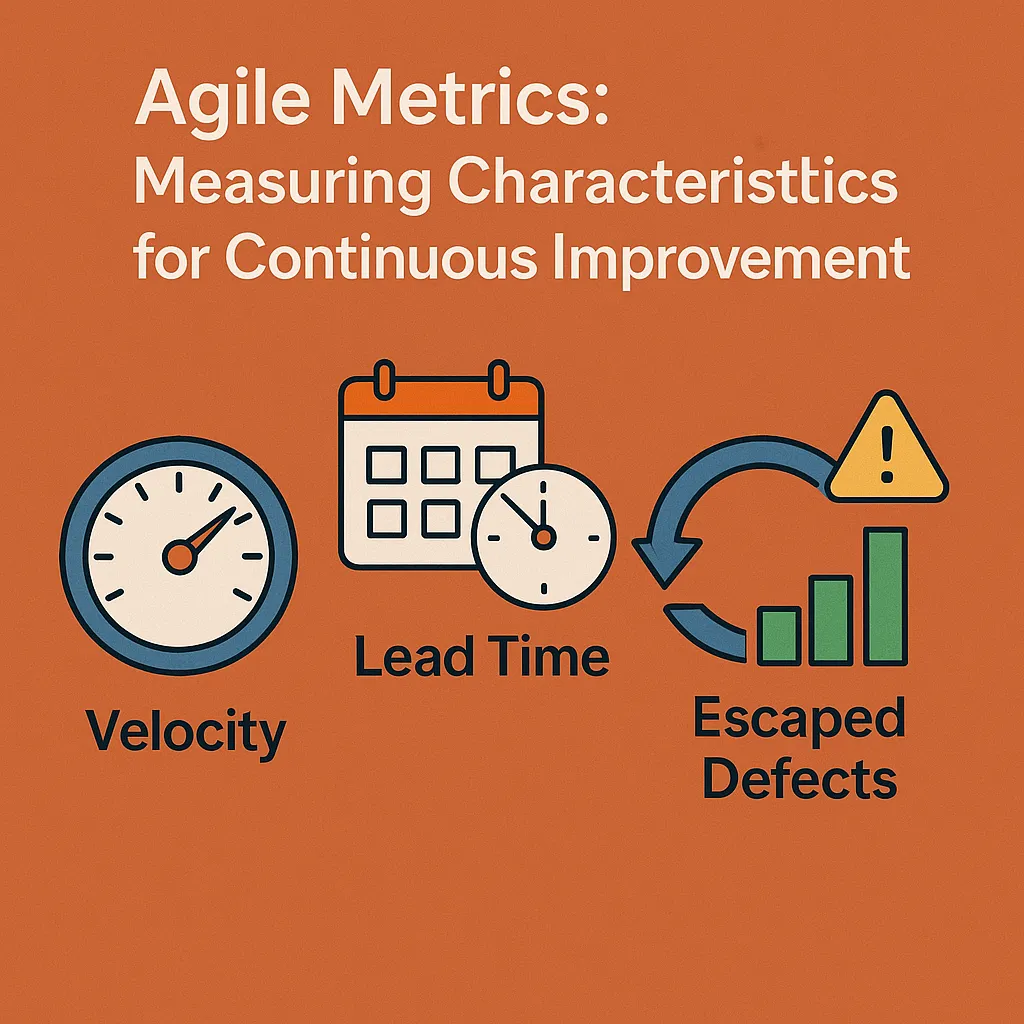Introduction to Agile Characteristics
Understanding and measuring agile characteristics is crucial for fostering an environment conducive to continuous improvement. Agile characteristics encompass several key attributes that define how teams operate and deliver value. These characteristics include:
- Flexibility: Agile methodologies prioritize adaptability, allowing teams to respond swiftly to changes in project requirements or market conditions. This flexibility enables teams to pivot and adjust their strategies as needed, ensuring that the project remains aligned with stakeholder expectations.
- Collaboration: Agile emphasizes teamwork and open communication among team members and stakeholders. This collaborative approach fosters a culture of shared responsibility and collective problem-solving, which is essential for overcoming challenges and achieving project goals.
- Customer Focus: At the heart of agile practices is a strong commitment to meeting customer needs. Agile teams engage with customers throughout the project lifecycle, gathering feedback and iterating on solutions to ensure that the final product delivers maximum value.
- Iterative Progress: Agile methodologies promote incremental development through short cycles known as sprints. This iterative approach allows teams to deliver functional components of the project regularly, facilitating early testing and feedback, which can lead to improved outcomes.
- Responsiveness: Agile teams are designed to be responsive to change, whether it comes from evolving customer requirements or unforeseen challenges. This responsiveness is a hallmark of agile practices, enabling teams to maintain momentum and adapt their plans effectively.
Importance of Measuring Agile Characteristics
Measuring these agile characteristics is vital for several reasons:
- Project Success: By quantifying agile characteristics, project managers can gain insights into the effectiveness of their processes and identify areas for improvement. Metrics provide a tangible way to assess whether the agile principles are being adhered to and how they contribute to project success.
- Continuous Improvement: Regularly measuring agile characteristics allows teams to reflect on their performance and make data-driven decisions. This focus on continuous improvement is essential for enhancing team dynamics, increasing productivity, and ultimately delivering better results.
- Stakeholder Engagement: Metrics can also serve as a communication tool with stakeholders, providing them with clear evidence of progress and areas needing attention. This transparency fosters trust and collaboration between teams and stakeholders.
Introducing Metrics in Agile Environments
In agile environments, metrics play a crucial role in tracking performance and guiding decision-making. Some common metrics include:
- Velocity: This measures the amount of work completed in a sprint, helping teams understand their capacity and plan future iterations more effectively.
- Lead Time and Cycle Time: These metrics track the time taken from the start of a task to its completion, providing insights into efficiency and areas where bottlenecks may occur.
- Customer Satisfaction: Gathering feedback through surveys or direct communication can help gauge how well the team is meeting customer needs and expectations.
- Team Engagement: Measuring team morale and engagement can provide insights into collaboration and overall team health, which are critical for sustaining agile practices.
By effectively measuring these characteristics, project managers and data analysts can ensure that agile methodologies are not only implemented but also optimized for ongoing success. This focus on metrics will ultimately lead to more successful project outcomes and a more resilient, adaptive organization.
Key Agile Characteristics to Measure
Measuring specific characteristics is crucial for fostering continuous improvement and ensuring project success. Here are the primary agile characteristics that should be measured, along with methods to evaluate their impact:
1. Customer Collaboration
Customer collaboration emphasizes the importance of engaging stakeholders throughout the project lifecycle. It ensures that the product aligns with customer needs and expectations.
Measurement Techniques:
- Surveys and Feedback Forms: Regularly distribute surveys to stakeholders to assess their satisfaction and engagement levels. Questions can focus on their involvement in decision-making and their perception of the project’s alignment with their needs.
- Net Promoter Score (NPS): Utilize NPS to gauge customer loyalty and satisfaction. This metric can provide insights into how likely customers are to recommend the product to others.
- Stakeholder Meetings: Track attendance and participation in meetings to evaluate engagement levels. Active participation can indicate a strong collaborative relationship.
2. Team Responsiveness
Team responsiveness refers to the ability of the project team to adapt to changes in requirements, priorities, or external conditions.
Measurement Techniques:
- Change Request Tracking: Monitor the number and nature of change requests submitted during the project. A high volume may indicate a need for better initial requirements gathering or flexibility in the process.
- Response Time Metrics: Measure the time taken to respond to change requests or feedback. Shorter response times can indicate a more agile and responsive team.
- Retrospective Analysis: Conduct regular retrospectives to discuss how well the team adapted to changes. Documenting lessons learned can help identify areas for improvement.
3. Iterative Progress
Iterative progress involves breaking the project into smaller, manageable increments (sprints) that allow for regular assessment and adjustment.
Measurement Techniques:
- Velocity Tracking: Measure the amount of work completed in each sprint (often in story points). This metric helps assess the team’s capacity and predict future performance.
- Burndown Charts: Utilize burndown charts to visualize the amount of work remaining versus time. This can help identify trends in productivity and areas where the team may be falling behind.
- Sprint Review Feedback: Collect feedback during sprint reviews to evaluate the effectiveness of each iteration. This can provide insights into what worked well and what needs adjustment.
4. Continuous Feedback
Continuous feedback is the practice of regularly soliciting input from stakeholders and team members to refine processes and products.
Measurement Techniques:
- Feedback Loop Frequency: Track how often feedback is solicited and acted upon. More frequent feedback loops can lead to quicker adjustments and improvements.
- Quality of Feedback: Assess the relevance and usefulness of the feedback received. This can be done through follow-up discussions or surveys to determine if the feedback led to meaningful changes.
- Implementation Rate: Measure the percentage of feedback that is implemented in subsequent iterations. A high implementation rate indicates that the team values and acts on stakeholder input.
By focusing on these key agile characteristics and employing effective measurement techniques, project managers and data analysts can gain valuable insights into their agile processes. This not only enhances project outcomes but also fosters a culture of continuous improvement within the team.
Establishing Metrics for Agile Characteristics
Establishing effective metrics is crucial for measuring characteristics that drive continuous improvement. This section will provide a framework for selecting and establishing metrics relevant to agile characteristics, focusing on both qualitative and quantitative measures.
1. Identifying Qualitative vs. Quantitative Metrics
When measuring agile characteristics, it is essential to differentiate between qualitative and quantitative metrics:
- Qualitative Metrics: These metrics provide insights into the subjective aspects of a project, such as team morale, customer satisfaction, and stakeholder engagement. They often involve feedback and can be gathered through surveys, interviews, or focus groups. For example, using open-ended questions in a survey can help gauge team sentiment and identify areas for improvement.
- Quantitative Metrics: These metrics are numerical and can be measured objectively. They provide concrete data that can be analyzed statistically. Examples include cycle time, which measures the time taken to complete a task, and velocity, which tracks the amount of work completed in a sprint. These metrics allow teams to assess their performance and make data-driven decisions.
2. Examples of Metrics
To effectively measure agile characteristics, consider the following examples of metrics:
- Net Promoter Score (NPS): This metric gauges customer satisfaction and loyalty by asking customers how likely they are to recommend a product or service. A high NPS indicates strong customer satisfaction, which is vital for agile teams focused on delivering value to customers.
- Cycle Time: This metric measures the time it takes for a task to move from the start of the development process to completion. Shorter cycle times indicate greater responsiveness and efficiency, allowing teams to adapt quickly to changing requirements.
- Velocity: In agile project management, velocity refers to the amount of work a team can complete in a given sprint, typically measured in story points. Tracking velocity helps teams understand their capacity and plan future sprints more effectively.
3. Aligning Metrics with Project Goals and Team Capabilities
The effectiveness of metrics lies in their alignment with project goals and the capabilities of the team. Here are some considerations for ensuring this alignment:
- Define Clear Objectives: Before selecting metrics, it is crucial to establish clear project objectives. Metrics should directly reflect these goals, ensuring that the team is measuring what truly matters for project success.
- Consider Team Dynamics: Different teams may have varying capabilities and workflows. Metrics should be tailored to fit the specific context of the team, taking into account their strengths and areas for improvement. For instance, a team with a high level of experience may have different velocity expectations compared to a newly formed team.
- Iterate and Adapt: Agile methodologies emphasize flexibility and adaptability. As projects evolve, so too should the metrics used to measure success. Regularly review and adjust metrics to ensure they remain relevant and aligned with changing project goals and team dynamics.
By establishing a robust framework for selecting and implementing metrics, project managers and data analysts can effectively measure agile characteristics, leading to enhanced performance and continuous improvement. This approach not only fosters a culture of accountability but also empowers teams to make informed decisions that drive project success.
Data Collection Methods for Agile Metrics
Measuring characteristics such as team performance, customer satisfaction, and process efficiency is crucial for continuous improvement. This section explores various methods for collecting data on agile characteristics, providing insights for data analysts and project managers looking to enhance their Agile practices.
1. Surveys and Questionnaires
Surveys and questionnaires are powerful tools for gathering feedback from both team members and customers. To design effective tools, consider the following:
- Clear Objectives: Define what you want to measure, such as team morale, customer satisfaction, or specific agile practices. This clarity will guide your question formulation.
- Question Types: Use a mix of closed-ended questions (e.g., Likert scale) for quantitative data and open-ended questions for qualitative insights. For example, ask team members to rate their satisfaction with the current sprint process and provide suggestions for improvement.
- Anonymity: Ensure anonymity to encourage honest feedback, especially on sensitive topics like team dynamics or leadership effectiveness.
- Frequency: Conduct surveys regularly (e.g., after each sprint) to track changes over time and identify trends in team and customer feedback.
2. Performance Tracking Tools
Utilizing software solutions to track agile metrics can provide real-time insights into team performance and project progress. Key features to look for in performance tracking tools include:
- Dashboards: Visual dashboards that display key metrics such as velocity, burn-down charts, and cycle time can help teams quickly assess their performance.
- Integration: Choose tools that integrate with existing project management software (e.g., Jira, Trello) to streamline data collection and analysis.
- Custom Metrics: Look for tools that allow customization of metrics to align with specific agile characteristics relevant to your team or project goals.
- Reporting Capabilities: Effective reporting features enable teams to generate insights and share findings with stakeholders, fostering transparency and accountability.
3. Regular Retrospectives
Regular retrospectives are essential for gathering qualitative data and fostering a culture of continuous improvement. To maximize the effectiveness of these sessions:
- Structured Format: Use a structured format (e.g., Start-Stop-Continue) to guide discussions and ensure all aspects of the agile process are covered.
- Facilitation: Appoint a neutral facilitator to encourage participation and keep discussions focused. This can help mitigate biases and ensure that all voices are heard.
- Action Items: Document actionable insights and assign responsibilities for follow-up. This ensures that feedback is not only collected but also acted upon, leading to tangible improvements.
- Follow-Up: In subsequent retrospectives, revisit previous action items to assess progress and make adjustments as necessary.
By employing these data collection methods, project managers and data analysts can effectively measure agile characteristics, leading to informed decision-making and continuous improvement in Agile practices.
Analyzing Agile Metrics
In the realm of project management, particularly within agile methodologies, understanding and measuring agile characteristics is crucial for fostering continuous improvement. This section delves into how to effectively analyze agile metrics, providing actionable insights for data analysts and project managers.
Setting Benchmarks and Targets
Defining success indicators for agile characteristics is the first step in measuring performance. Here are some key considerations:
- Identify Key Performance Indicators (KPIs): Establish specific KPIs that align with agile principles, such as team velocity, cycle time, and lead time. These metrics help gauge the efficiency and effectiveness of the agile process.
- Establish Baselines: Use historical data to set benchmarks. This allows teams to understand their starting point and measure progress over time. For instance, if a team’s average velocity is 30 story points per sprint, this becomes a baseline for future sprints.
- Set SMART Goals: Ensure that targets are Specific, Measurable, Achievable, Relevant, and Time-bound. For example, a target could be to increase the team’s velocity by 10% over the next three sprints, providing a clear and actionable goal.
Data Visualization Techniques
Effective data visualization is essential for presenting metrics in a way that facilitates team discussions and decision-making. Consider the following tools and techniques:
- Dashboards: Utilize agile project management tools like Jira or Trello to create dashboards that display real-time metrics. These dashboards can include charts and graphs that visualize team velocity, burndown charts, and cumulative flow diagrams.
- Infographics: Create infographics that summarize key metrics and trends. This can help in communicating complex data in a more digestible format, making it easier for stakeholders to understand the agile process.
- Heat Maps: Use heat maps to identify areas of concern or improvement within the team’s workflow. For example, a heat map can show which tasks are taking longer than expected, highlighting bottlenecks in the process.
Interpreting Results
Once data is collected and visualized, the next step is to interpret the results to inform decision-making. Here’s how to approach this:
- Identify Trends: Look for patterns in the data over time. For instance, if the team’s velocity is consistently increasing, it may indicate improved efficiency. Conversely, a decline in velocity could signal issues that need to be addressed.
- Conduct Root Cause Analysis: When trends indicate problems, perform a root cause analysis to understand the underlying issues. This could involve team discussions or retrospective meetings to gather insights on what might be affecting performance.
- Make Data-Driven Decisions: Use the insights gained from data analysis to inform strategic decisions. For example, if data shows that certain types of tasks consistently take longer, consider adjusting the team’s approach to those tasks or providing additional training.
By effectively measuring and analyzing agile characteristics, project managers and data analysts can drive continuous improvement within their teams. This not only enhances productivity but also fosters a culture of transparency and collaboration, essential for successful agile project management.
Continuous Improvement through Agile Metrics
The ability to measure and analyze characteristics is crucial for fostering a culture of continuous improvement. Agile metrics serve as a compass, guiding teams toward enhanced performance and adaptability. Here, we explore how effectively measuring agile characteristics can lead to significant improvements in project outcomes.
Using Metrics to Identify Areas for Improvement
Metrics in agile project management provide valuable insights into team performance and project health. By analyzing these metrics, teams can pinpoint specific areas that require enhancement. For instance:
- Velocity Tracking: By measuring the amount of work completed in each sprint, teams can identify patterns in productivity. If velocity decreases over time, it may indicate issues such as team burnout or unclear requirements. A case study from a software development team showed that by regularly reviewing velocity, they were able to adjust their sprint planning and workload, leading to a 20% increase in productivity over three months.
- Cycle Time Analysis: This metric measures the time taken from the start of a task to its completion. A team that noticed an increase in cycle time for certain tasks implemented a root cause analysis, discovering bottlenecks in their workflow. By addressing these issues, they reduced their cycle time by 30%, significantly improving their delivery speed.
Implementing Changes Based on Metrics
Once areas for improvement are identified through metrics, the next step is implementing changes. Best practices for agile teams include:
- Regular Retrospectives: Conducting retrospectives at the end of each sprint allows teams to reflect on their performance and discuss metrics openly. This practice encourages team members to share insights and collaboratively develop action plans for improvement.
- Setting SMART Goals: Specific, Measurable, Achievable, Relevant, and Time-bound (SMART) goals derived from metrics can help teams focus their efforts. For example, if a team identifies that their defect rate is higher than desired, they can set a goal to reduce it by 15% in the next quarter by enhancing their testing processes.
- Experimentation and Feedback Loops: Agile teams thrive on experimentation. By implementing small changes and measuring their impact, teams can learn what works best. For instance, a team that experimented with pair programming found that it not only improved code quality but also fostered better collaboration, leading to a more cohesive team environment.
Fostering a Culture of Adaptability and Learning
A culture of continuous improvement is rooted in adaptability and learning. Agile metrics play a pivotal role in nurturing this culture by:
- Encouraging Open Communication: Metrics should be shared transparently among team members. This openness fosters trust and encourages team members to discuss challenges and successes, leading to collective learning.
- Promoting a Growth Mindset: By framing metrics as tools for growth rather than as punitive measures, teams can cultivate a mindset that embraces change and values learning from failures. For example, a team that views a drop in customer satisfaction scores as an opportunity to gather feedback and improve their product will likely see better long-term results.
- Celebrating Small Wins: Recognizing and celebrating improvements, no matter how small, can motivate teams to continue striving for excellence. Metrics can help highlight these wins, reinforcing the behaviors that lead to success.
Challenges in Measuring Agile Characteristics
Measuring agile characteristics in project management is essential for fostering continuous improvement, yet it comes with its own set of challenges. Understanding these challenges and developing strategies to address them can significantly enhance the effectiveness of agile practices. Here are some common challenges faced when measuring agile characteristics, along with suggestions for overcoming them:
1. Subjectivity in Qualitative Data
One of the primary challenges in measuring agile characteristics is the inherent subjectivity of qualitative data. Feedback from team members can vary widely based on personal experiences and perspectives, leading to potential bias. To minimize this bias, consider the following strategies:
- Standardized Feedback Mechanisms: Implement structured feedback forms or surveys that guide respondents to provide specific, actionable insights. This can help ensure that feedback is focused and relevant.
- Anonymity in Responses: Encourage anonymous feedback to reduce social pressure and allow team members to express their true opinions without fear of repercussions.
- Regular Calibration Sessions: Hold regular meetings to discuss feedback and ensure that all team members have a shared understanding of the criteria being evaluated. This can help align perceptions and reduce discrepancies in feedback.
2. Over-reliance on Metrics
While quantitative metrics are valuable for assessing performance, an over-reliance on them can lead to a narrow view of team dynamics and project health. Balancing quantitative data with qualitative insights is crucial for a holistic understanding of agile characteristics. Here are some approaches to achieve this balance:
- Integrate Qualitative Insights: Pair quantitative metrics (like velocity or burn-down charts) with qualitative assessments (such as team morale or collaboration effectiveness) to provide a more comprehensive view of performance.
- Focus on Leading Indicators: Instead of solely relying on lagging indicators (like project completion rates), incorporate leading indicators that can provide early insights into team dynamics and potential issues.
- Encourage Open Discussions: Foster an environment where team members feel comfortable discussing qualitative aspects of their work. Regular retrospectives can serve as a platform for these discussions, allowing teams to reflect on both metrics and personal experiences.
3. Resistance to Change
Introducing new measurement practices can often meet with resistance from team members who may be accustomed to existing processes. Addressing these concerns is vital for successful implementation. Consider the following strategies:
- Involve the Team in the Process: Engage team members in discussions about the need for new measurement practices and how they can contribute to improvement. This involvement can help foster buy-in and reduce resistance.
- Provide Training and Resources: Offer training sessions that explain the benefits of new measurement practices and how they can enhance team performance. Providing resources can help alleviate fears and build confidence in using new tools.
- Highlight Success Stories: Share examples of how effective measurement has led to improvements in other teams or projects. Demonstrating tangible benefits can motivate team members to embrace new practices.
By recognizing and addressing these challenges, project managers and data analysts can effectively measure agile characteristics, leading to enhanced team performance and continuous improvement in agile practices.
Conclusion
Measuring agile characteristics is not just beneficial; it is essential for fostering continuous improvement and ensuring project success. Here are the key takeaways to consider:
- Importance of Measuring Agile Characteristics: Understanding and quantifying agile characteristics—such as team collaboration, customer satisfaction, and delivery speed—provides valuable insights into the effectiveness of agile practices. These metrics help teams identify strengths and weaknesses, enabling them to make informed decisions that enhance overall performance.
- Ongoing Evaluation and Adaptation of Metrics: Agile is inherently iterative, and so should be the approach to metrics. Regularly evaluating the relevance and effectiveness of the metrics in use allows teams to adapt to changing project dynamics and stakeholder needs. This continuous feedback loop is crucial for maintaining alignment with agile principles and ensuring that the metrics serve their intended purpose.
In conclusion, the effective measurement of agile characteristics not only supports the agile methodology but also empowers teams to achieve higher levels of efficiency and satisfaction. By committing to ongoing evaluation and adaptation, project managers and data analysts can significantly enhance their agile practices, ultimately leading to more successful project deliveries.
Find out more about Shaun Stoltz https://www.shaunstoltz.com/about/.
This post was written by an AI and reviewed/edited by a human.



